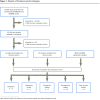Systematic review of clinical features of suspected prostate cancer in primary care
- PMID: 25756146
- PMCID: PMC4301783
Systematic review of clinical features of suspected prostate cancer in primary care
Abstract
Objective: To systematically review the literature and provide an update and integration of existing peer-reviewed guidelines with recent systematic reviews and with primary studies related to the early recognition and management of prostate cancer in primary care.
Data sources: We searched MEDLINE and EMBASE for relevant articles. The quality of the evidence to support existing guideline recommendations and the consistency of recommendations with updated evidence were assessed. Applicability in a Canadian primary care setting was also evaluated.
Study selection: All studies conducted in the primary care setting that provided information on clinical features predictive of prostate cancer were included. Also, studies that assessed the accuracy of nomograms to predict prostate cancer were reviewed.
Synthesis: The findings suggest that lower urinary tract symptoms are not highly predictive of prostate cancer. However, evidence suggests that FPs might be good at discriminating between patients with and without prostate cancer using digital rectal examination and prostate-specific antigen testing. Nomograms might also be useful in assessing patients for aggressive prostate cancers.
Conclusion: The results of this review can be used to inform recommendations for referral for suspected prostate cancer in the primary care setting. They could also inform development of prostate cancer diagnostic assessment programs.
Objectif: Faire une revue systématique de la littérature à propos des plus récentes directives vérifiées par des pairs et de leur application, et ce, à l’aide de revues systématiques récentes et d’études portant sur la détection précoce et sur le traitement du cancer de la prostate en contexte de soins primaires.
Sources des données: On a consulté MEDLINE et EMBASE à la recherche d’articles pertinents. La qualité des preuves à l’appui des directives existantes et leur cohérence avec les données les plus récentes ont été évaluées. On a également vérifié leur applicabilité dans un milieu de soins primaires au Canada.
Choix des études: On a retenu toutes les études effectuées en contexte de soins primaires qui contenaient des informations sur les caractéristiques cliniques prédictives de cancer prostatique. Ont aussi été examinées les études qui évaluaient la précision des nomogrammes comme facteur prédictif d’un cancer prostatique.
Synthèse: Ces résultats suggèrent que les symptômes du tractus urinaire distal ne constituent pas de très bons prédicteurs du cancer de la prostate. Les données suggèrent toutefois que les MF pourraient être habiles pour distinguer les patients souffrant ou non de cancer grâce au toucher rectal et au dosage de l’antigène prostatique spécifique. Des nomogrammes pourraient également être utiles pour évaluer les patients qui ont un cancer prostatique agressif.
Conclusion: Les résultats de cette revue peuvent servir à indiquer aux soignants de première ligne les cas où un patient qu’on suspecte d’avoir un cancer prostatique doit être dirigé en spécialité. Ils pourraient aussi susciter le développement de programmes d’évaluation du diagnostic du cancer de la prostate.
Figures
Similar articles
-
Screening for prostate cancer.Cochrane Database Syst Rev. 2013 Jan 31;2013(1):CD004720. doi: 10.1002/14651858.CD004720.pub3. Cochrane Database Syst Rev. 2013. PMID: 23440794 Free PMC article.
-
Interventions for promoting habitual exercise in people living with and beyond cancer.Cochrane Database Syst Rev. 2018 Sep 19;9(9):CD010192. doi: 10.1002/14651858.CD010192.pub3. Cochrane Database Syst Rev. 2018. PMID: 30229557 Free PMC article.
-
MRI software and cognitive fusion biopsies in people with suspected prostate cancer: a systematic review, network meta-analysis and cost-effectiveness analysis.Health Technol Assess. 2024 Oct;28(61):1-310. doi: 10.3310/PLFG4210. Health Technol Assess. 2024. PMID: 39367754 Free PMC article.
-
Signs and symptoms to determine if a patient presenting in primary care or hospital outpatient settings has COVID-19.Cochrane Database Syst Rev. 2022 May 20;5(5):CD013665. doi: 10.1002/14651858.CD013665.pub3. Cochrane Database Syst Rev. 2022. PMID: 35593186 Free PMC article.
-
Clinical symptoms, signs and tests for identification of impending and current water-loss dehydration in older people.Cochrane Database Syst Rev. 2015 Apr 30;2015(4):CD009647. doi: 10.1002/14651858.CD009647.pub2. Cochrane Database Syst Rev. 2015. PMID: 25924806 Free PMC article.
Cited by
-
Perceptions about screening for prostate cancer using genetic lifetime risk assessment: a qualitative study.BMC Fam Pract. 2018 Feb 17;19(1):32. doi: 10.1186/s12875-018-0717-6. BMC Fam Pract. 2018. PMID: 29454309 Free PMC article.
-
Early economic evaluation of magnetic resonance imaging for prostate cancer detection in primary care.BJUI Compass. 2024 Jul 10;5(9):855-864. doi: 10.1002/bco2.409. eCollection 2024 Sep. BJUI Compass. 2024. PMID: 39323927 Free PMC article.
-
Phytochemicals in Prostate Cancer: From Bioactive Molecules to Upcoming Therapeutic Agents.Nutrients. 2019 Jun 29;11(7):1483. doi: 10.3390/nu11071483. Nutrients. 2019. PMID: 31261861 Free PMC article. Review.
-
Study of Glabranin as an Inhibitor Against Prostate Cancer: Molecular Docking, Molecular Dynamics Simulation, MM-PBSA Calculation and QSAR Prediction.Indian J Clin Biochem. 2024 Jul;39(3):331-343. doi: 10.1007/s12291-023-01134-3. Epub 2023 Apr 1. Indian J Clin Biochem. 2024. PMID: 39641116 Free PMC article.
-
Systematic review and meta-analysis of the diagnostic accuracy of prostate-specific antigen (PSA) for the detection of prostate cancer in symptomatic patients.BMC Med. 2022 Feb 7;20(1):54. doi: 10.1186/s12916-021-02230-y. BMC Med. 2022. PMID: 35125113 Free PMC article.
References
-
- Cancer.ca [website] What is cancer? Toronto, ON: Canadian Cancer Society; 2011. Available from: www.cancer.ca/Canada-wide/About%20cancer/Cancer%20statistics.aspc?sc_lan.... Accessed 2011 Dec 2.
-
- National Institute for Health and Care Excellence. Referral guidelines for suspected cancer. NICE guideline CG27. London, UK: National Institute for Health and Care Excellence; 2005.
-
- New Zealand Guidelines Group. Suspected cancer in primary care: guidelines for investigation, referral and reducing ethnic disparities. Wellington, NZ: New Zealand Guidelines Group; 2009.
-
- Reitsma JB, Rutjes AW, Whiting P, Vlassov VV, Leeflang MM, Deeks JJ. Chapter 9: assessing methodological quality. In: Deeks JJ, Bossuyt PM, Gatsonsi C, editors. Cochrane handbook for systematic reviews of diagnostic test accuracy, version 1.0.0. London, UK: Cochrane Collaboration; 2009. Available from: http://srdta.cochrane.org/handbook-dta-reviews. Accessed 2014 Dec 1.
Publication types
MeSH terms
Substances
LinkOut - more resources
Full Text Sources
Medical
Miscellaneous

